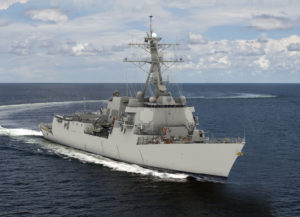The White House on July 12 released a Statement of Administration Policy that opposes several Navy and missile defense changes made by the House Armed Services Committee (HASC) from the FY ‘23 budget request, notably adding a floor of amphibious ships and funding a third destroyer.
The administration opposes a provision that establishes a minimum number of Navy amphibious ships “or other numeric force structure provisions, as they unduly constrain evolutions in joint warfighting approaches and associated capability prioritization.”
The House Armed Services Committees’ (HASC) FY ‘23 National Defense Authorization Act version includes a provision from the Seapower and projection Forces subcommittee mark that would set a statutory floor of 31 traditional L-class amphibious vessels. It also would prohibit the Navy from retiring five of 24 ships it was to decommission including the USS Vicksburg (CG-69) Germantown (LSD-42), Gunston Hall (LSD-44), Tortuga (LSD-46) and Ashland (LSD-48) (Defense Daily, June 7).
The bill also requires the Secretary of the Navy to consult with the Commandant of the Marine Corps on all major decisions concerning the amphibious force structure or capability.
Over the last several months, several Marine Corps officials testified before congressional panels that if the amphibious force goes down to 24 ships over the next few years, as the Navy’s budget and 30-year shipbuilding plan project, the service would provide adequate capability in the Indo-Pacific region but take more risk in other areas (Defense Daily, May 19).
Over the next five years, the Navy’s plan would reduce the amphibious force from the current level of 31 to 24 ships by FY ‘24 because it would retire Whidbey Island/Harpers Ferry-class dock landing ships (LSDs) between three and 14 years earlier than planned. The amphibious force would not get back up to 31 again until at least 2030, if the Navy’s plans hold.

The administration also objected to incremental funding a third Arleigh Burke-class destroyer in FY ‘23.
The HASC approved an amendment during the bill markup that increased the total defense topline by $37 billion, including adding another destroyer with incremental funding for it (Defense Daily, June 22).
The bill also authorizes the Navy Secretary to enter into a multi-year procurement contract for up to 15 destroyers, as has been approved in the past. The Navy has generally bought two destroyers per year, split between shipbuilders General Dynamics’ Bath Iron Works (BIW) [GD] and HII’s Ingalls Shipbuilding [HII]. If the Navy was to buy 15 destroyers over the five-year procurement contract, the shipyards would have to increase production to 1.5 destroyers each per year, allowing for three ships procured per year.
Separately, the White House said it opposes provisions that require the Missile Defense Agency (MDA) to quickly acquire three Vertical Launch Systems (VLS) for the Navy to operate for defense of Guam by the end of 2023.
The bill includes a provision concerned with the Defense Department’s plans to defend Guam from various missile threats. It directs the Secretary of Defense, via the director of the MDA, to “rapidly procure and field up to three vertical launching systems that can accommodate planned interceptors operated by the Navy” by Dec. 31, 2023.
The Secretary of Defense can waive the requirement only if they determine it is in the best interest of U.S. national security, submits a notification of the waiver with a justification to the defense committees, and enacts the waiver 120 days after notifying Congress.
The administration argued this provision is detrimental because “the planned defense of Guam architecture has undergone a risk mitigation assessment with the intent to expedite capability delivery in a phased approach. Long lead items for a vertical launch system will be procured in FY 2022 and the mobile launcher design modifications will be conducted in parallel.”
In March, MDA revealed the architecture it chose to defend Guam includes mobile units utilizing Lockheed Martin [LMT] Aegis combat system, Raytheon Technologies [RTX] Standard Missile (SM)-3 and SM-6 missiles, and the Northrop Grumman [NOC] Integrated Air and Missile Defense Battle Command System (IBCS) as well as maintaining the Terminal High Altitude Area Defense (THAAD) system already on the island (Defense Daily, March 29).
MDA Director Vice Adm. Jon Hill previously said the work is feasible but the agency still has to make sure it will have movable launchers that can carry SM-3 and SM-6 missiles. He noted this is not a significant change in engineering, because the Army currently uses mobile missile launchers.